Key takeaways:
- Tuscan Ribollita is a traditional dish, rooted in peasant culture, made from leftover bread and seasonal vegetables, highlighting innovation in frugality.
- The recipe emphasizes the importance of communal meals, creating connections and memories among family and friends through shared experiences.
- Key ingredients, including stale bread, kale, and cannellini beans, come together to create a nourishing soup, with patience and improvisation being crucial for perfecting the dish.
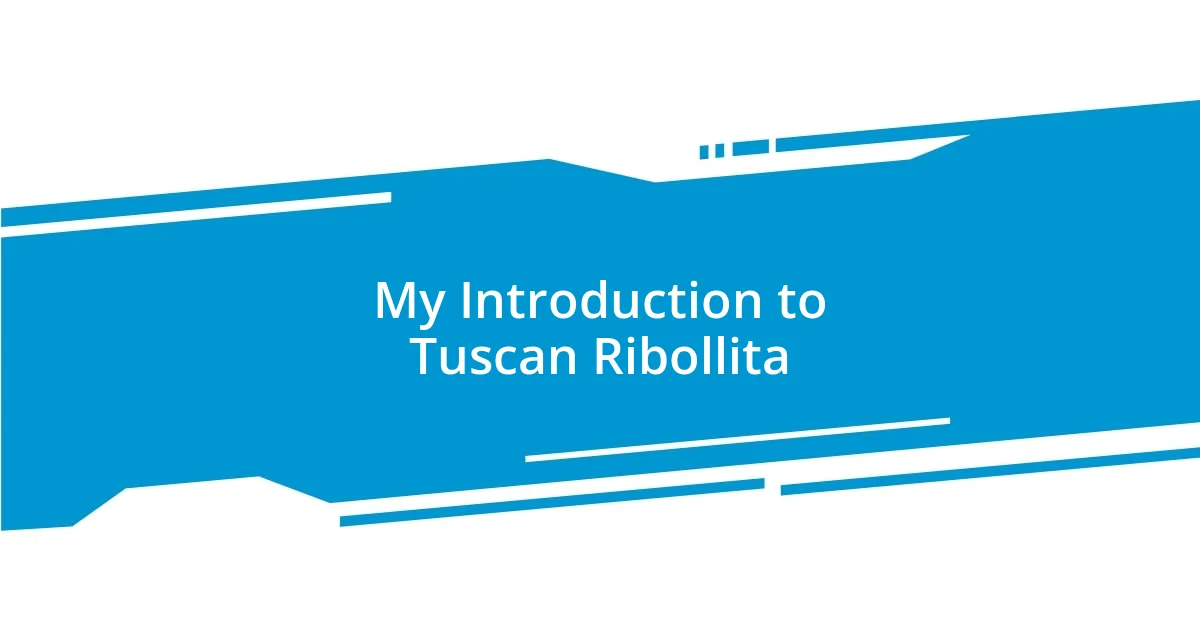
My Introduction to Tuscan Ribollita
I first stumbled upon Tuscan Ribollita during a charming dinner in a quaint little trattoria in Florence. The warmth of the restaurant wrapped around me like a cozy blanket, and I couldn’t resist diving into this hearty soup that promised both comfort and tradition. As I took my first spoonful, the rich flavors danced on my palate, and I thought, “How can something so simple be so incredibly satisfying?”
My introduction to Ribollita was more than just a culinary experience; it was a lesson in history and culture. I remember chatting with the chef, who excitedly shared stories about how this dish originated from humble beginnings, crafted by farmers making the most of leftover bread and vegetables. That moment made me reflect: isn’t it fascinating how food can carry such deep-rooted stories through generations?
The aroma wafting from the kitchen evoked a sense of nostalgia that I didn’t even know I had. I felt connected to the Italian landscape, as if I were sitting at my grandmother’s kitchen table. Have you ever tasted something that immediately transported you to another place? For me, Ribollita was that magical dish, connecting me to both the past and present in a delightful, soul-nourishing way.
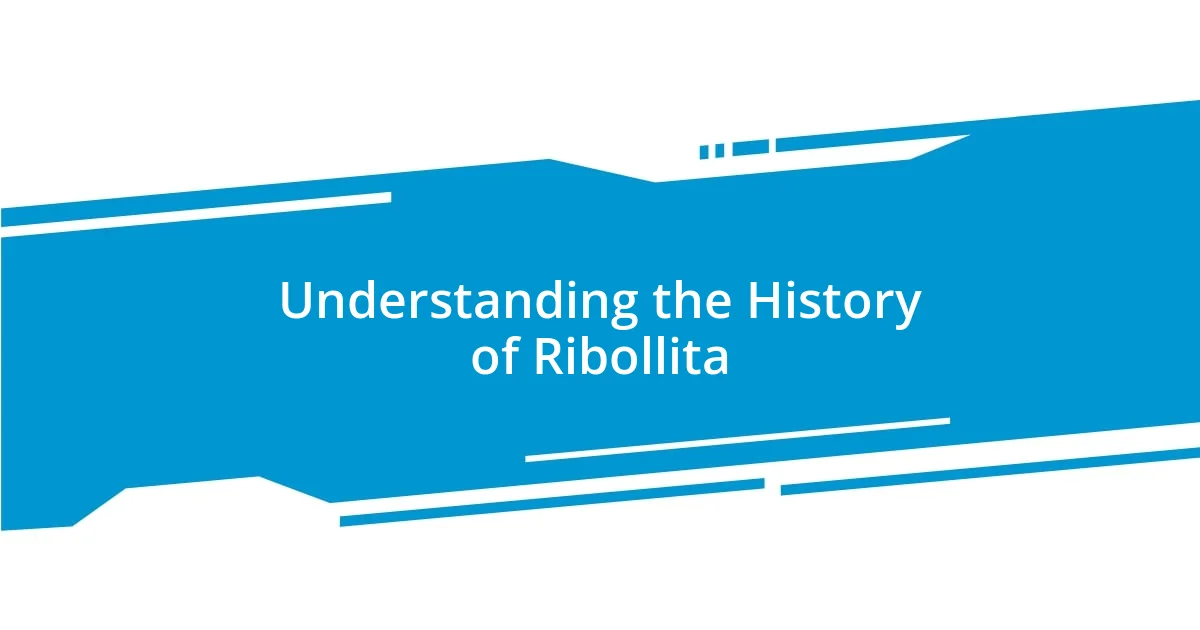
Understanding the History of Ribollita
The history of Ribollita is a fascinating reflection of Tuscan culture, rooted in the practice of frugality. Traditionally, this dish emerged among the peasant class who needed to make their meals last longer, bringing to life their ingenuity in using stale bread and seasonal vegetables. I love imagining those old Tuscan kitchens bustling with families, turning what might seem like leftovers into a meal that would nourish both body and soul.
As I learned more, I discovered that the name “Ribollita” itself means “reboiled.” This reference to the reheating process captures the heart of its origin—through time, the flavors meld and deepen, much like the stories shared around the table. It reminds me of how my own family tends to revisit cherished recipes, adding a pinch of creativity each time, further enriching their tale with every meal shared.
The communal aspect of Ribollita enhances its significance. It’s more than just a soup; it epitomizes the warmth of gatherings, where families and friends unite to enjoy simple yet profound nourishment. I can almost hear the laughter and chatter, blending with the rich aroma of the soup simmering on the stove, creating memories that stretch beyond the dinner plate. Isn’t it incredible how a humble dish can carry such weight in tradition and emotion?
| Key Aspects | Description |
|---|---|
| Origin | Developed by peasants using leftover ingredients |
| Name Meaning | “Reboiled,” highlighting the reheating tradition |
| Significance | A communal dish that promotes family gatherings |

Key Ingredients for Authentic Ribollita
When I think of Ribollita, the first things that come to mind are its key ingredients that come together to create this unforgettable dish. Each component has a purpose, adding layers of flavor and heartiness that truly define this soup. It’s like a beautiful melody, where every note plays its part, and I can nearly visualize the vibrant colors of the fresh vegetables mingling together in the pot.
Here are the essential ingredients that give Ribollita its authentic taste:
- Stale bread: This is the backbone of the dish. It absorbs the broth and brings a rustic texture.
- Kale or cavolo nero: This dark, leafy green contributes a beautiful earthiness and nutritional value.
- Carrots and celery: These aromatic vegetables form the base, enhancing the overall flavor profile.
- Tomatoes: Whether fresh or canned, they add acidity and sweetness, balancing the richness of the bread.
- Cannellini beans: They provide protein and creaminess, making the soup feel both filling and satisfying.
- Olive oil: A drizzle at the end elevates the dish, adding richness and depth to each spoonful.
I remember my first time watching a local chef prepare Ribollita, and the way she skillfully chopped the vegetables with such care struck me. The vibrant greens, the subtle crunch of the carrots, all swirling in a pot that simmered like the heartbeat of the kitchen. The aroma enveloped us like a warm embrace, and I felt an overwhelming sense of community. Those fresh ingredients transformed not just the soup but the very atmosphere—it was comforting and joyous, an experience I’ll cherish forever.

Step by Step Ribollita Recipe
To prepare Ribollita, start by heating a generous amount of olive oil in a large pot. I always prefer to use high-quality oil, as it truly makes a difference in flavor. Once it’s shimmering, toss in diced onions, carrots, and celery, letting them soften and caramelize. The aroma that fills your kitchen at this stage is simply heavenly, isn’t it?
Next, add chopped kale and your choice of tomatoes. If you’re using canned tomatoes, I find that crushing them by hand gives a nice texture, allowing the juices to meld beautifully with the other ingredients. Stir everything together and then add in your broth, letting it come to a gentle simmer. I get a little lost in that moment, imagining how all those flavors are going to meld together—you can already sense the magic, right?
After the soup has simmered for about 30 minutes, stir in the stale bread and cannellini beans. This is the point where the Ribollita really begins to take shape. The bread will absorb the broth and create a lovely, thick consistency. I love the anticipation I feel at this moment; it’s like waiting for a secret to unfold. Let it sit for a while to cool and reheat before serving. I like to serve it with a final drizzle of olive oil and a sprinkle of fresh parsley on top. Isn’t it gratifying how a simple process can result in something so nourishing and rich in flavor?
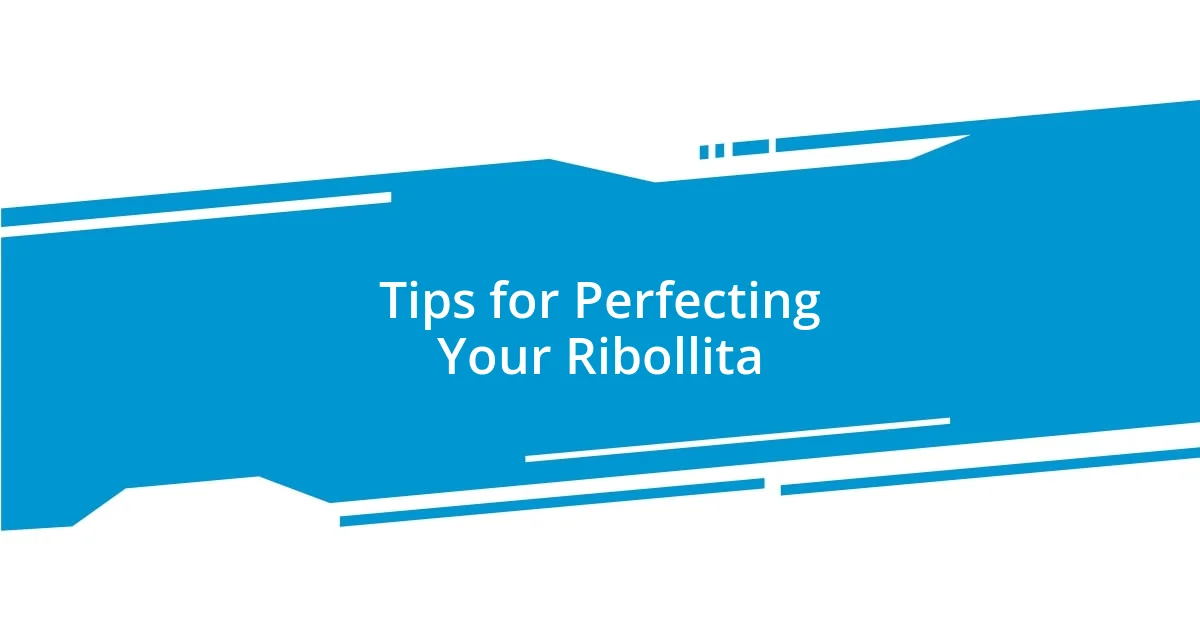
Tips for Perfecting Your Ribollita
To truly perfect your Ribollita, patience is key. I learned this the hard way during my early attempts at the dish, rushing the simmering process. Letting it simmer slowly allows the flavors to develop and meld, creating that cozy depth everyone craves. I often find myself checking in on it, stirring occasionally, lost in the aroma wafting through the air—it’s an experience in itself, isn’t it?
Another tip I highly recommend is to embrace the use of leftover ingredients. Ribollita is traditionally a peasant dish, and it thrives on improvisation. During a chilly evening, I found that using leftover chunks of roasted vegetables not only added character but also made me feel resourceful. Have you ever thought about how simple ingredients can elevate a meal? When you’re creative with what’s on hand, every batch of Ribollita becomes a personal masterpiece.
Finally, don’t underestimate the finishing touches. A drizzle of high-quality olive oil at the end does wonders, adding a burst of flavor that ties everything together. I remember once hosting a small gathering, and my guests didn’t quite believe there was a mere drizzle of oil that could elevate the meal. As they took their first spoonful, their surprise echoed as their faces lit up. Isn’t it incredible how such small details can create lasting impressions?
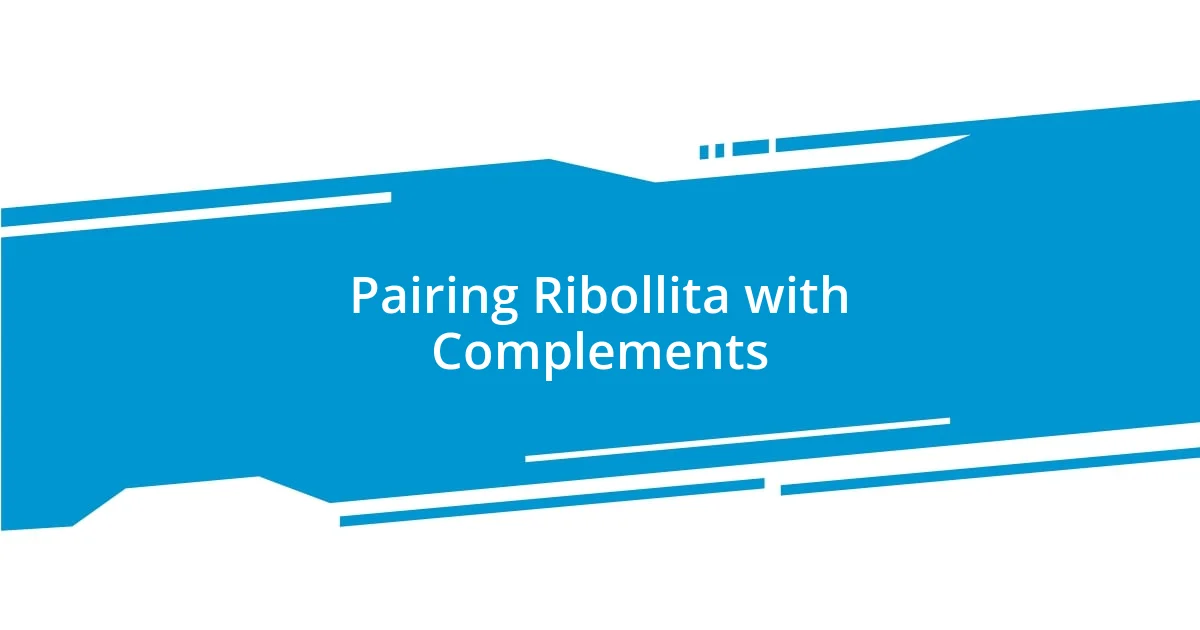
Pairing Ribollita with Complements
Pairing Ribollita with the right complements can really accentuate its rich flavors. I remember a winter evening when I served my Ribollita alongside a simple mixed greens salad dressed with a light vinaigrette. The fresh crunch of the salad was a delightful contrast to the hearty, dense soup, bringing balance to the meal. Doesn’t it feel wonderful when a dish feels complete?
When it comes to bread, I believe you can’t go wrong with crusty, toasted sourdough. The first time I tried this pairing, I was amazed at how each dip of the bread into the Ribollita created a pop of flavor that felt both comforting and luxurious. The tang of the sourdough intertwined beautifully with the savory depth of the soup, almost like the two were made for each other. Have you ever experienced a pairing that just clicks like that?
For the perfect finish, I often serve my Ribollita with a glass of Chianti. One memorable dinner involved sharing this authentic pairing with close friends, and we were all captivated by how the wine brought out the rustic notes in the soup. It felt like a celebration of Tuscan tradition right in my kitchen. Wouldn’t you agree that the right beverage can truly elevate the dining experience?
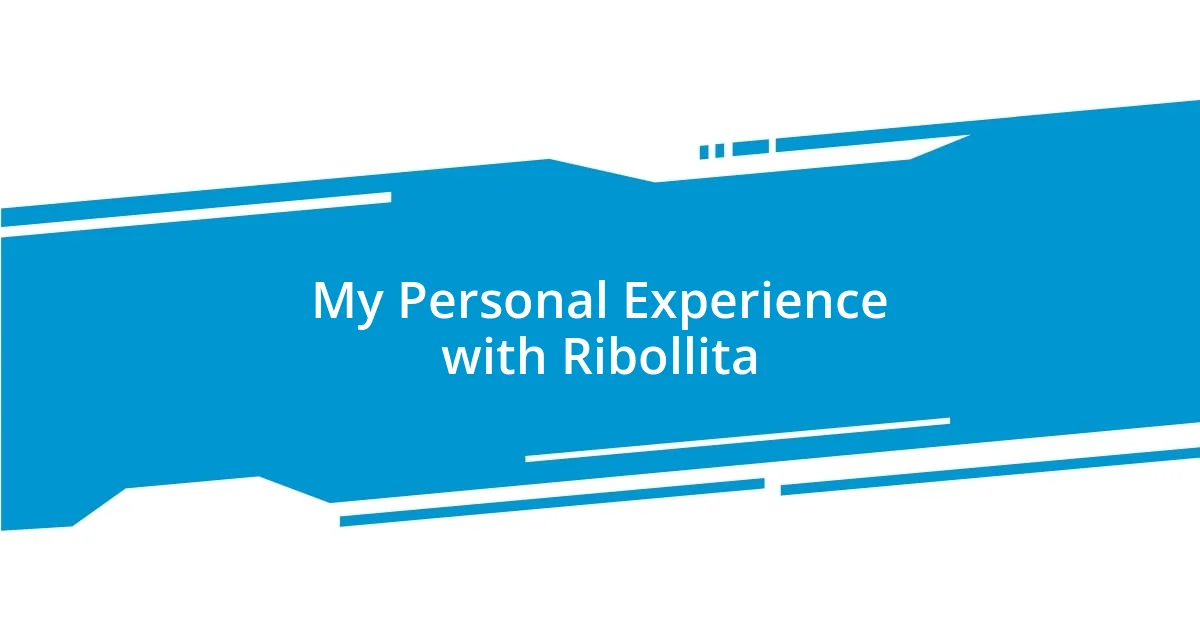
My Personal Experience with Ribollita
I still recall the first time I made Ribollita. It was a rainy afternoon, and the sound of rain tapping on my window set the perfect backdrop for what I hoped would be a heartwarming meal. As I stirred the pot, watching the vegetables soften and the broth bubble, an overwhelming sense of comfort washed over me. Isn’t it fascinating how certain dishes can transport you to a different time or place?
On another occasion, I decided to experiment with a few spices, recalling a Tuscan market visit where scents of fresh herbs filled the air. I added a pinch of smoked paprika, and as the flavors blended, I was instantly reminded of the warmth of Italian hospitality. This twist not only brought a new depth to the soup but also sparked a delightful conversation with friends who gathered around my table. Have you ever found inspiration in unexpected moments like that?
One of my cherished memories with Ribollita happened during a family gathering. The warmth of the soup matched the joy of being surrounded by loved ones. I can still hear the laughter as we shared our stories over bowls of Ribollita, each person finding their own favorite element within the dish. Isn’t it incredible how a simple meal can weave the fabric of our connections, creating memories to cherish for years to come?
















